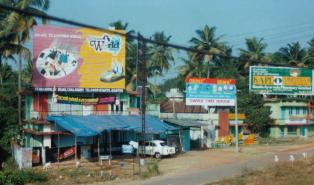|

- Saturday
5th January 2002; Coonoor
- At the tea
plantation we were ushered into the sorting room
at its top level. here we watched pickers
dropping the contents of their bags into a hopper.
I assume these contents were from the racks of
leaves which had first had 50% of their moisture
removed by having cold air blown across and
through them.
- Now we descended by
stairs to the next floor where we were asked not
to take photographs. Here the dried leaves were,
by a series of rollers, converted to a poweder
for use in teabags. Then followed a three hour
fermentation as warm moist air passed through the
mixture.
- As it came by
assembly roller from here we noticed that the tea
smelled distinctly 'tea-like' for the first time.
Our guide then led us to the factory shop where
we sampled strong tea, chocolate and masala tea.
I was impressed and bought a five hundred gram
bag each of the latter two.
- I'd also noticed
that the aromatic 'breath-freshening' mixture of
herbs and spices I had sampled several times in
Sri Lanka - to clean our mouths at the conclusion
of a meal - was available in small sealed bags.
|



